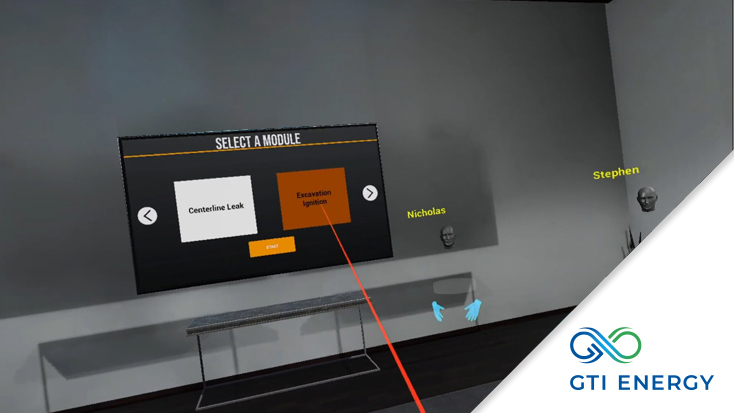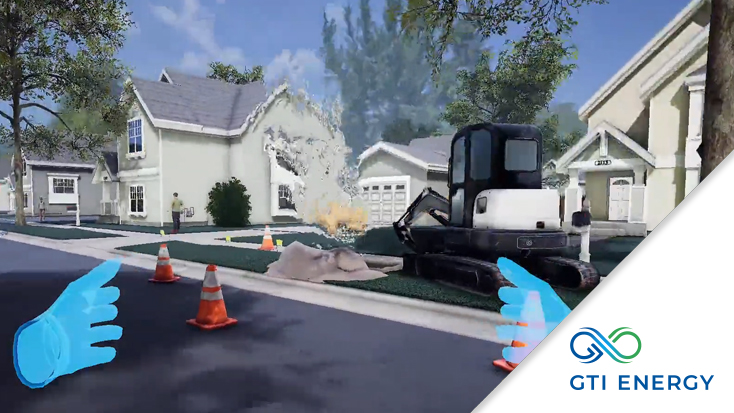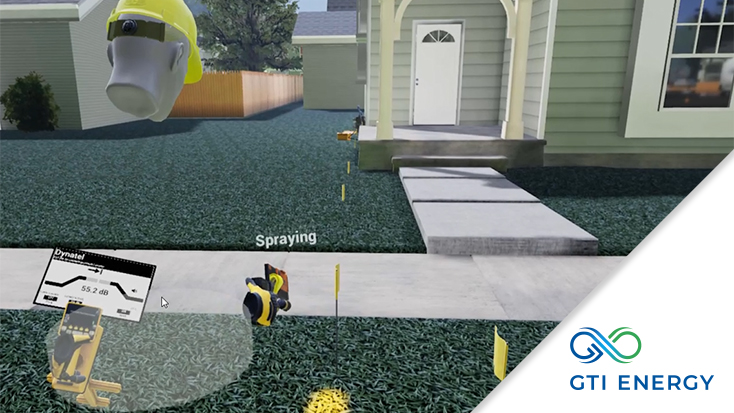Add digital immersion and interaction to enhance hands-on training
GTI Energy is harnessing VR training experiences to replicate real-world environments and provide safe, engaging, hands-on training on crucial topics, often deemed high-risk for in-person education. Learners undergo training in immersive headsets or non-immersive desktop platforms, preparing themselves to perform operations safely and efficiently in the field. Training solutions can incorporate numerous features, including the following:
- Multi-user: Multi-user functionality allows up to dozens of trainees to interact and collaborate in a single environment at one time—from multiple endpoints, potentially anywhere in the world.
- Scenario Randomization: Scenario randomization ensures trainees stay alert and engaged as they’re presented with virtually limitless potential hazards, situational details, and environmental considerations.
- Reporting: Real-time reporting & analytics provide actionable feedback for trainees, clear visibility into trainee performance for training managers and supervisors, and in-depth data that reveals micro- and macro-level trends that can be leveraged to improve the long-term effectiveness of training.
- 3D Environments: Photo-realistic 3D environments dissolve the barrier between virtual and actual reality and create a setting for true-to-life accuracy.
- Simulated Consequences: Simulated consequences and functional real-world tools put the pressure on trainees to respond quickly and become familiar with tools that will be used regularly on the job.
View our offerings below.

VR Training Overview

VR Training Demo: Natural Gas Leak Emergency Response

VR Training Demo: Facility Locating and Marking
Available VR Training Modules
Based on overwhelming response to the first VR training module on natural gas leaks, GTI Energy has enhanced the module and launched a suite of VR training modules on activities for other critical missions. They include:
Natural Gas Leak Emergency Response
Natural Gas Leak Emergency Response challenges trainees to search for, find, and properly respond to a potentially deadly simulated gas leak in a residential neighborhood. With multi-user functionality, scenario randomization, and real-time reporting analytics, it’s the most advanced, intense, and engaging VR Training ever created for the energy industry.
Facility Locating and Marking
Use established real-world training methods and critical thinking skills to search for, find, and mark-off the location of natural gas facilities. Use industry tools and observational techniques to complete the tasks while recognizing and reacting to any Abnormal Operating Conditions (AOCs) encountered.
Pipeline Patrolling
Use real-life training methods and critical thinking skills to patrol a stretch of transmission pipeline to ensure the pipeline is properly marked and to identify any Abnormal Operating Conditions (AOCs) that could threaten the integrity and safety of the pipeline.
Outside Leak Investigation
Participants access a residential neighborhood to complete the required task of investigating possible gas leaks outside dwellings and buildings. Multiple types of leaks may be present. Participants use the same tools they will be using in the field to bar-hole and measure gas concentrations. Once the source of the leak is identified, participants follow the procedures of pinpointing the exact location of the leak and then makes the appropriate communications to have the leak reported and repaired.
Inside Meter Inspections
Participants learn how to correctly perform an indoor gas meter inspection. Scenario randomization challenges participants with millions of different situations — a variety of meter configurations, gas leaks, signs of corrosion, tampering - exposing them to dozens of real life situations in a matter of hours that would traditionally take them months, or longer, for them to be exposed to these same situations out in field.
Inside Leak Investigation
Participants enter a residential property to conduct a thorough investigation of a customer-reported gas leak in their residence. Using their decision-making skills and available tools, participants must determine if a leak exists, identify its source, and take appropriate steps to resolve the leak.
Stand-by Activities
Participants access excavation sites where gas mains are being exposed. The participant must assess the job site to determine if excavation procedures are being followed properly based on the facility markings that may or may not be present. After they assess the situation, they must communicate with the excavation crew regarding the correct course of action. Participants must recognize and react to abnormal operation conditions (AOC) to prevent damage to the gas main.
Appliance Inspection
A multi-step safety inspection to ensure technicians can do safely and successfully inspect appliances in the field. Trainees use real-life methods in a simulated environment to identify any potential hazards, incorrect connection methods, or other safety concerns surrounding natural gas appliances.
Gas Handling
Participants access varied excavation sites, to complete gas pipeline hot tapping tasks in residential neighborhoods. The module includes abandonment, main extension, and cut-out scenarios. Using available materials and resources, the participant must determine the order of actions and complete the task safely and timely.
Learn More
Contact the energy training experts today
